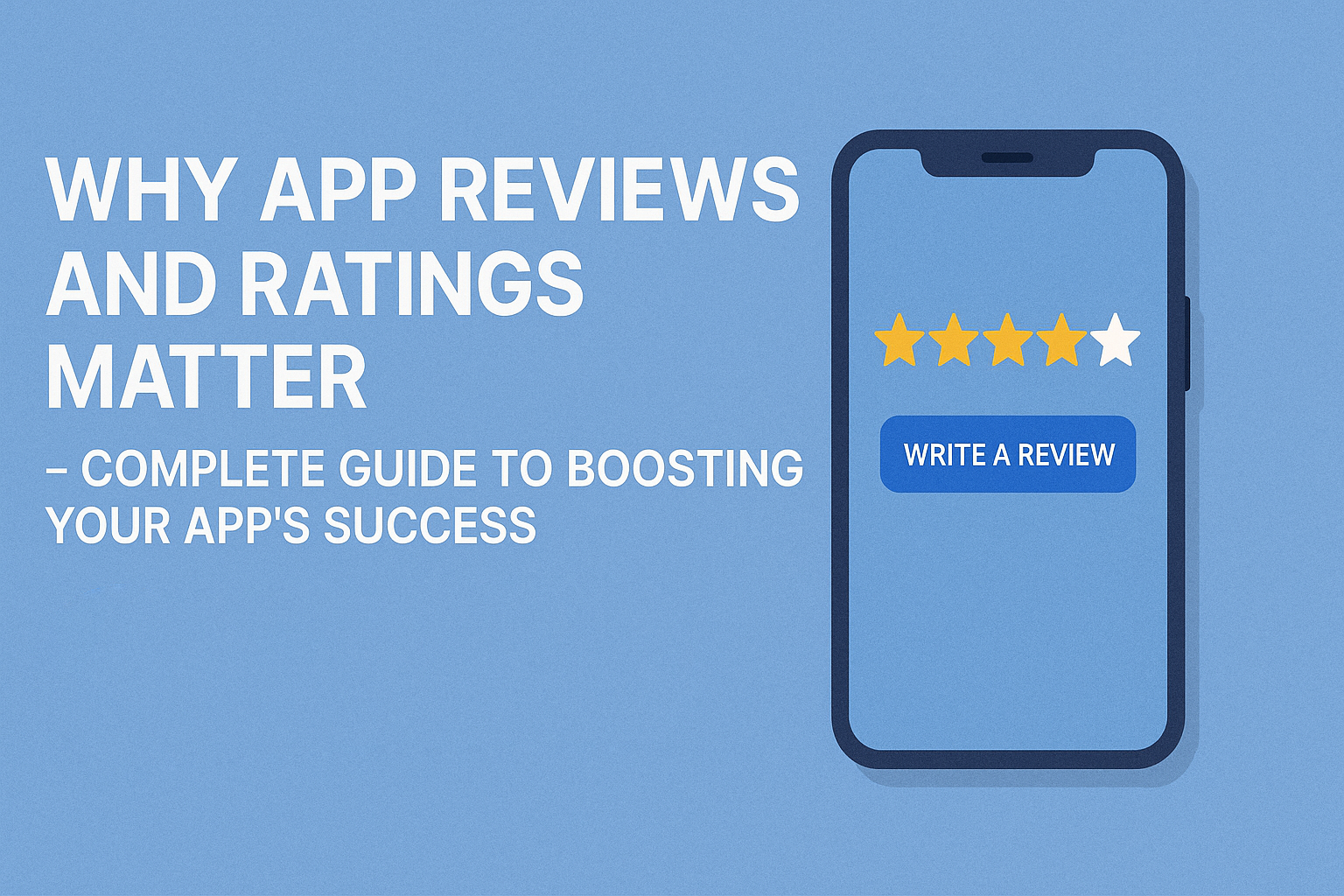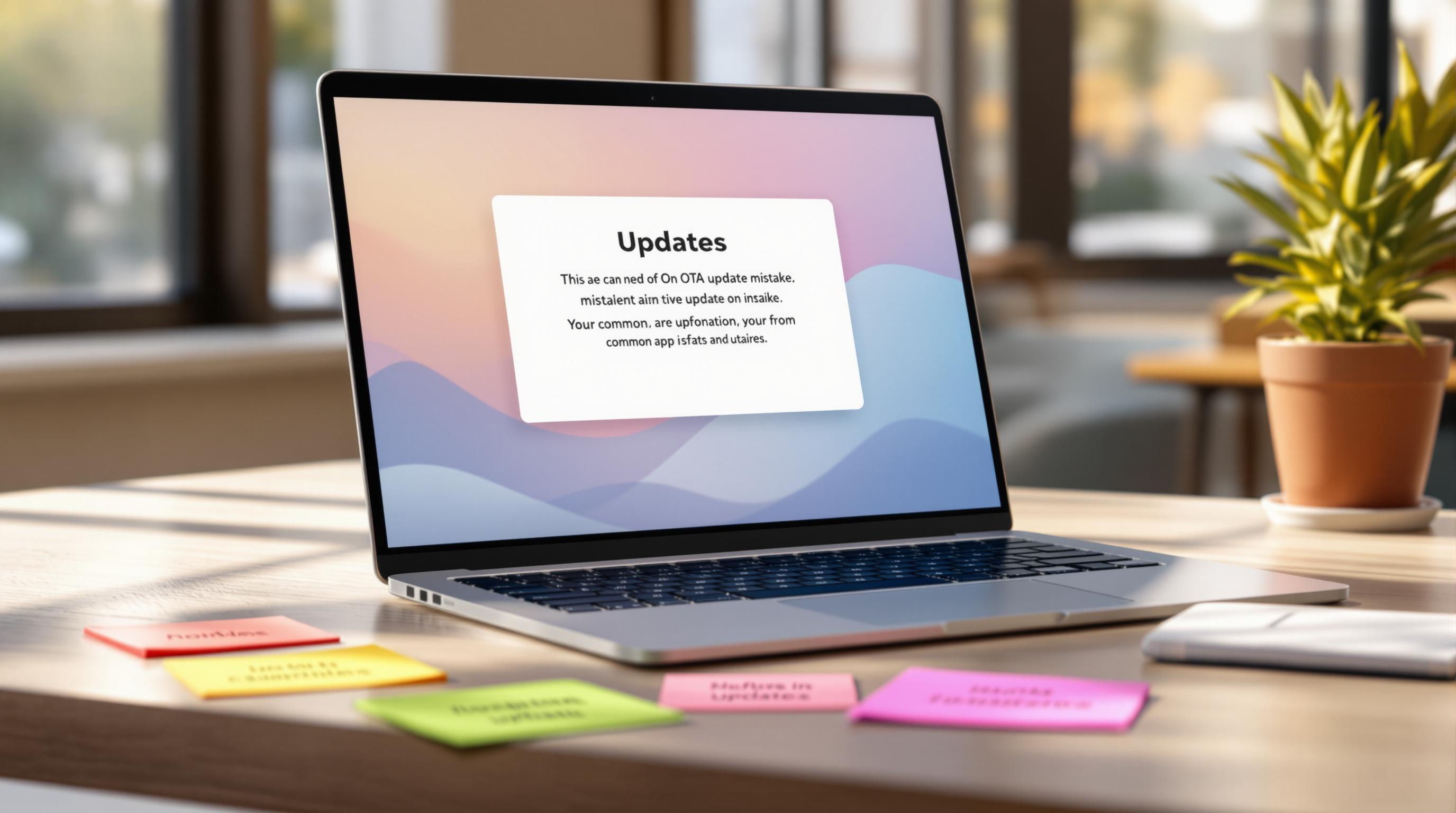App reviews and ratings are far more than vanity metrics—they’re critical factors that determine your app’s visibility, credibility, and ultimate success in the App Store and Google Play Store. Whether you’re launching your first app or managing an established product, understanding how to leverage reviews and ratings can dramatically impact your downloads and revenue.
In this comprehensive guide, we’ll explore why reviews and ratings matter, how they affect your app’s performance, and proven strategies to encourage more positive feedback from your users.
Why App Reviews and Ratings Are Critical
The Power of Social Proof
App ratings and reviews serve as public feedback that shows potential users what existing customers think about your app. In a marketplace with millions of apps competing for attention, reviews act as the primary trust signal for users deciding whether to download your app.
Key statistics:
- Apps with higher ratings (4.0+) see conversion rates up to 4x higher than lower-rated apps
- 79% of users check ratings and reviews before downloading an app
- The first few reviews can make or break a new app’s success
Impact on App Store Rankings
Both Apple and Google consider ratings and reviews as ranking factors, though they handle them differently:
Google Play Store:
- Apps with many positive ratings and reviews receive more browse and explore traffic
- High-rated apps are more likely to be featured in curated collections
- An app needs approximately 4.0 average stars minimum to be recommended by Google Play
- User reviews are indexed for keywords, directly impacting search rankings
- Recent ratings carry more weight than older ones
Apple App Store:
- Apps with strong ratings appear higher in search results
- Positive reviews increase conversion rates on your app listing page
- High ratings improve eligibility for Today tab features
- Ratings affect the “You might also like” recommendations
- Reviews don’t directly impact keyword rankings (unlike Google Play)
Conversion Rate Multiplier
Your app’s rating is one of the first things users see when they land on your app store page. The difference between a 3.5-star and 4.5-star rating can be dramatic:
- 4.5+ stars: Premium perception, high trust, strong conversion
- 4.0-4.4 stars: Good perception, acceptable trust, solid conversion
- 3.5-3.9 stars: Questionable quality, reduced trust, lower conversion
- Below 3.5 stars: Major red flag, minimal trust, very low conversion
Studies show that improving your rating from 3.8 to 4.2 stars can increase your conversion rate by 50% or more.
Key Differences Between App Stores
Understanding how each platform handles reviews and ratings helps you optimize your strategy for both.
Google Play Store Review System
How It Works:
- Gives more weight to recent app version ratings
- Displays both the most positive AND most critical reviews prominently
- Allows users to update their rating after you respond to their review
- Cannot reset ratings—your history follows you
- Reviews are indexed and impact search rankings
Review Display:
- Shows approximately 6 reviews on the main listing
- Highlights the most helpful positive and negative reviews
- Displays developer responses inline with reviews
Strategic Advantage:
- Keywords in reviews help your SEO
- Developer responses can turn negative reviews into positive outcomes
- Users can change ratings after seeing developer engagement
Apple App Store Review System
How It Works:
- Calculates ratings across the app’s entire lifetime (unless reset)
- Allows rating resets with new major versions (though not recommended)
- Does not index review keywords for ranking purposes
- Highlights approximately 6 reviews on listing pages
- Separate ratings for each version
Review Display:
- Shows “Most Helpful” reviews first
- Displays current version rating separately from all versions
- Developer responses appear below individual reviews
Strategic Advantage:
- Can reset ratings with major updates (use sparingly)
- In-app review prompts use native iOS system
- Users can rate without writing a review
Best Practices for Managing Reviews and Ratings
1. Respond to Reviews Strategically
Developer responses are one of the most powerful tools for managing your app’s reputation.
Prioritization Strategy:
- Respond to 1-2 star ratings first - These cause the most damage and offer the biggest opportunity
- Address technical issue mentions - Shows you’re actively fixing bugs
- Thank positive reviewers - Encourages continued support
- Reply to constructive criticism - Demonstrates you listen to feedback
Response Best Practices:
For negative reviews:
Thank you for your feedback, [Name]. We're sorry to hear about [specific issue].Our team has identified and fixed this problem in version [X.X]. Please updateto the latest version and let us know if you still experience any issues. We'recommitted to providing you with the best experience possible.
- [Your Name], [Your App] TeamFor positive reviews:
Thank you so much for the 5-star review, [Name]! We're thrilled to hear thatyou're enjoying [specific feature they mentioned]. Your support means everythingto our team. If you ever have suggestions, we'd love to hear them atsupport@yourapp.com.
- [Your Name], [Your App] TeamWhy This Matters:
- A developer response can reduce the impact of a negative review by up to 50%
- Users who see developer responses are 3x more likely to download
- On Google Play, users often update their rating after receiving a helpful response
- Shows potential users that you actively maintain and improve your app
2. Implement Strategic In-App Review Prompts
The timing and context of your review requests dramatically impact success rates.
When to Ask:
- ✅ After a user completes a positive action (completed a level, finished a workout, completed a purchase)
- ✅ After multiple successful sessions (user has engaged 5-7+ times)
- ✅ When user achieves a milestone or goal
- ✅ After resolving a customer support issue positively
When NOT to Ask:
- ❌ Immediately after app launch or installation
- ❌ During onboarding or tutorial
- ❌ Right after an error or crash
- ❌ When user is in the middle of a task
- ❌ More than once every few months
Implementing In-App Reviews with Capacitor
Both iOS and Android provide native in-app review APIs that show a seamless, non-intrusive prompt within your app. Using Capacitor, you can easily implement this functionality.
Recommended Plugin: @capacitor-community/in-app-review
Installation:
npm install @capacitor-community/in-app-reviewnpx cap syncBasic Implementation:
import { InAppReview } from '@capacitor-community/in-app-review';
async function requestReview() { try { await InAppReview.requestReview(); } catch (error) { console.log('Review request not shown:', error); }}Strategic Implementation with User Behavior Tracking:
import { InAppReview } from '@capacitor-community/in-app-review';import { Preferences } from '@capacitor/preferences';
async function checkAndRequestReview() { // Get user engagement data const { value: sessionCount } = await Preferences.get({ key: 'sessionCount' }); const { value: lastReviewRequest } = await Preferences.get({ key: 'lastReviewRequest' });
const sessions = parseInt(sessionCount || '0'); const lastRequest = parseInt(lastReviewRequest || '0'); const daysSinceLastRequest = (Date.now() - lastRequest) / (1000 * 60 * 60 * 24);
// Only ask if user has used app at least 5 times // and hasn't been asked in the last 90 days if (sessions >= 5 && (daysSinceLastRequest > 90 || !lastRequest)) { try { await InAppReview.requestReview();
// Store the request timestamp await Preferences.set({ key: 'lastReviewRequest', value: Date.now().toString() }); } catch (error) { console.log('Review prompt not shown:', error); } }}
// Call after positive user actionasync function onUserCompletedGoal() { // Increment session counter const { value: sessionCount } = await Preferences.get({ key: 'sessionCount' }); const newCount = (parseInt(sessionCount || '0') + 1).toString(); await Preferences.set({ key: 'sessionCount', value: newCount });
// Check if we should request review await checkAndRequestReview();}Advanced Implementation with Sentiment Detection:
import { InAppReview } from '@capacitor-community/in-app-review';import { Preferences } from '@capacitor/preferences';
class ReviewManager { private static MINIMUM_SESSIONS = 5; private static MINIMUM_DAYS_BETWEEN_REQUESTS = 90; private static POSITIVE_ACTIONS_THRESHOLD = 3;
static async trackPositiveAction(actionType: string) { const { value } = await Preferences.get({ key: 'positiveActions' }); const actions = JSON.parse(value || '[]');
actions.push({ type: actionType, timestamp: Date.now() });
await Preferences.set({ key: 'positiveActions', value: JSON.stringify(actions) });
// Check if user qualifies for review request await this.checkReviewEligibility(); }
static async trackNegativeAction(actionType: string) { // Reset positive action counter on negative events await Preferences.set({ key: 'positiveActions', value: JSON.stringify([]) }); }
private static async checkReviewEligibility() { const { value: sessionCount } = await Preferences.get({ key: 'sessionCount' }); const { value: lastRequest } = await Preferences.get({ key: 'lastReviewRequest' }); const { value: actionsValue } = await Preferences.get({ key: 'positiveActions' });
const sessions = parseInt(sessionCount || '0'); const lastRequestTime = parseInt(lastRequest || '0'); const actions = JSON.parse(actionsValue || '[]'); const daysSinceLastRequest = (Date.now() - lastRequestTime) / (1000 * 60 * 60 * 24);
const isEligible = sessions >= this.MINIMUM_SESSIONS && actions.length >= this.POSITIVE_ACTIONS_THRESHOLD && (daysSinceLastRequest > this.MINIMUM_DAYS_BETWEEN_REQUESTS || !lastRequestTime);
if (isEligible) { await this.requestReview(); } }
private static async requestReview() { try { await InAppReview.requestReview();
// Store request timestamp await Preferences.set({ key: 'lastReviewRequest', value: Date.now().toString() });
// Reset positive actions counter await Preferences.set({ key: 'positiveActions', value: JSON.stringify([]) });
} catch (error) { console.log('Review request not shown:', error); } }}
// Usage in your appasync function onWorkoutCompleted() { await ReviewManager.trackPositiveAction('workout_completed');}
async function onGoalAchieved() { await ReviewManager.trackPositiveAction('goal_achieved');}
async function onErrorOccurred() { await ReviewManager.trackNegativeAction('error');}Important Platform Limitations:
iOS Restrictions:
- The system automatically limits review prompts to 3 times per year per user
- You cannot trigger the prompt on demand—it’s controlled by the system
- Users can disable review prompts entirely in their settings
- Don’t show your own “Please Rate Us” dialog before calling the API
Android Restrictions:
- Google Play enforces a quota on review prompts
- The prompt may not show if the user has already reviewed your app
- Reviews may not appear immediately in Play Console
- The API works only for apps distributed through Google Play
Best Practice: Never add a “Rate Our App” button that calls requestReview(). The system may not show the prompt (especially if the user has hit their quota), resulting in a broken experience. Instead, use a button that opens the app store page directly:
import { InAppReview } from '@capacitor-community/in-app-review';
async function openAppStorePage() { // Opens the app store page where users can always leave a review await InAppReview.openAppStore({ appId: '1234567890' // Your app's ID });}3. Analyze Competitor Reviews for Market Insights
Your competitors’ reviews are a goldmine of market intelligence.
What to Look For:
- Features users request most frequently
- Common complaints or pain points
- Pricing feedback
- UX/UI issues mentioned repeatedly
- Feature comparisons to other apps
- Bugs that competitors haven’t fixed
How to Use This Data:
- Build features that users are begging competitors for
- Fix problems that plague your category
- Position your app to fill gaps in the market
- Improve your marketing messaging based on real user language
4. Create a Systematic Review Monitoring Process
Weekly Review Check:
- Read all new reviews on both platforms
- Respond to negative reviews within 24-48 hours
- Thank users who leave detailed positive feedback
- Track recurring themes or issues
- Monitor competitor reviews
Monthly Analysis:
- Track average rating trend
- Identify most common feedback themes
- Measure impact of responses on rating updates (Google Play)
- Review sentiment analysis
- Correlate reviews with app versions
Tools to Consider:
- App Store Connect (iOS analytics)
- Google Play Console (Android analytics)
- AppFollow, Sensor Tower, or App Annie (cross-platform monitoring)
- Custom scripts to export and analyze review data
Advanced Strategies to Improve Ratings
1. Version-Specific Rating Strategy (iOS)
On iOS, you can see separate ratings for your current version vs. all versions. This creates an opportunity:
Strategy:
- Launch a major update with significant improvements
- Prompt active, engaged users to review the new version
- The fresh version rating can overshadow older negative reviews
- Apple shows both ratings, but users focus on current version
When to Use:
- After fixing major bugs
- After adding highly-requested features
- After significant UX improvements
- After re-branding or major redesign
Important: Only reset ratings when you have genuine, substantial improvements. Users and Apple can see through manipulation tactics.
2. Segment Your Review Requests
Not all users should be prompted for reviews. Segment your user base:
High-Value Segments (More Likely to Leave Positive Reviews):
- Power users who engage daily
- Users who completed onboarding successfully
- Paying customers/subscribers
- Users who contacted support and had their issue resolved
- Users who completed key actions successfully
Low-Value Segments (Avoid Requesting Reviews):
- Users who haven’t completed onboarding
- Users who experienced crashes or errors recently
- Users who contacted support with unresolved issues
- Free users who haven’t engaged with core features
- Users who just installed the app
3. Respond Strategically to Negative Reviews
Your response to negative reviews isn’t just for the reviewer—it’s for all future visitors to your app page.
Response Framework:
-
Acknowledge the Issue: “Thank you for bringing this to our attention. We understand how frustrating [specific issue] must be.”
-
Take Responsibility: “We apologize for this experience. This doesn’t meet our standards.”
-
Provide Solution: “We’ve fixed this issue in version X.X, which is now available. Please update and try again.”
-
Invite Further Contact: “If you continue to experience issues, please reach out to us at support@yourapp.com so we can assist you directly.”
-
Sign Personally: ”- John, [App Name] Support Team”
Example Response Template:
Hi [Name],
Thank you for your feedback, and we sincerely apologize for the frustrating experiencewith [specific issue]. This is not the level of quality we strive for.
We've identified and resolved this problem in our latest update (version X.X), whichis now available in the [App/Play] Store. After updating, please try [specific action]again, and it should work smoothly.
If you continue to experience any issues, please don't hesitate to contact us directlyat support@yourapp.com. We're committed to making this right.
We appreciate your patience and hope you'll give us another chance to provide you witha great experience.
Best regards,[Your Name][Your App] Support Team4. Use Email Campaigns to Request Reviews
For apps with user accounts, email can be an effective channel for review requests.
Email Review Request Best Practices:
Subject Lines That Work:
- “Quick question about [App Name]”
- “Help us improve [App Name]”
- “We’d love your feedback on [App Name]”
Email Template:
Subject: We'd love to hear what you think about [App Name]
Hi [Name],
We noticed you've been using [App Name] for [time period], and we wanted to reachout personally to say thank you!
Your feedback would be incredibly valuable to us and to other users who areconsidering [App Name]. Would you mind taking 30 seconds to share your thoughts?
[Rate on iOS] [Rate on Android]
We read every review and use your feedback to make [App Name] better.
Thank you for your support!
Best,[Your Name][Your Title]When to Send:
- After 5-7 positive app sessions
- After completing a significant action
- 1-2 weeks after subscription start
- After positive customer service interaction
Frequency: No more than once every 6 months per user.
Common Mistakes to Avoid
1. Asking Too Early or Too Often
The Problem: Prompting new users for reviews before they’ve experienced your app’s value frustrates users and leads to lower ratings.
The Solution: Wait until users have demonstrated engagement and success with your app.
2. Ignoring Negative Reviews
The Problem: Unresponded negative reviews signal abandonment and discourage downloads.
The Solution: Respond to every negative review within 48 hours, even if just to acknowledge the issue.
3. Incentivizing Reviews
The Problem: Both Apple and Google explicitly prohibit incentivizing reviews with rewards, discounts, or features.
The Solution: Never offer anything in exchange for reviews. Focus on creating a great product that naturally encourages positive feedback.
4. Faking Reviews
The Problem: Fake reviews violate store policies and can result in app removal and account termination.
The Solution: Never buy reviews, use review services, or have employees post fake reviews. Build genuine reviews through great UX.
5. Only Prompting Happy Users
The Problem: While it’s smart to segment users, completely avoiding feedback from dissatisfied users means you miss critical improvement opportunities.
The Solution: Create alternative feedback channels for users who might be unhappy:
import { InAppReview } from '@capacitor-community/in-app-review';
async function handleFeedbackRequest() { // First, ask user if they're enjoying the app const isHappy = await showDialog({ title: "Are you enjoying [App Name]?", message: "We'd love to hear your thoughts!", buttons: ["Yes!", "Not really"] });
if (isHappy === "Yes!") { // Request app store review await InAppReview.requestReview(); } else { // Direct to feedback form or support showFeedbackForm({ title: "We're sorry to hear that", message: "What can we improve?", onSubmit: async (feedback) => { await sendToSupportTeam(feedback); showThankYou("Thank you! We'll work on this."); } }); }}Note: While this pre-qualification approach can work, be careful not to make it feel manipulative. A better approach is to use behavioral signals (completed actions, engagement frequency) rather than asking users directly.
Measuring Success: Key Metrics to Track
Monitor these metrics to understand the impact of your review and rating strategy:
1. Average Rating Trend
Track how your rating changes over time:
- Overall app rating
- Current version rating (iOS)
- Rating by country/region
- Rating trend after major updates
Goal: Steady upward trend or stable 4.0+ rating
2. Review Volume
Monitor the number of reviews you receive:
- Total reviews per week/month
- Reviews per download (review rate)
- Reviews by star rating distribution
- Response rate to reviews
Goal: Increasing review volume, especially 4-5 star reviews
3. Review Sentiment
Analyze the content of reviews:
- Positive vs. negative sentiment
- Feature mentions (positive and negative)
- Bug/crash mentions
- Competitor comparisons
Tools: Manual analysis, App Annie, Sensor Tower, or custom NLP scripts
4. Conversion Rate Impact
Measure how ratings affect your conversion:
- Conversion rate at different rating levels
- Conversion rate before/after major rating improvements
- A/B testing with different review counts
Expected Impact: Each 0.1 star improvement can increase conversion by 5-10%
5. Developer Response Impact
Track the effectiveness of your responses:
- Rating updates after developer responses (Google Play)
- Time to first response
- Response rate percentage
- Sentiment change after responses
Goal: 90%+ response rate to negative reviews, sub-24-hour response time
Need Help Improving Your App’s Rankings and Reviews?
Managing app reviews and ratings is just one piece of the app store optimization puzzle. If you’re looking to maximize your app’s potential in the App Store and Google Play Store, our team can help.
Book a consultation with our ASO experts for personalized guidance on:
- App Store Optimization (ASO) strategy
- Review and rating management
- In-app review implementation with Capacitor
- Competitive analysis and positioning
- Conversion rate optimization
- App store listing optimization
- Keyword research and optimization
- A/B testing strategies
We’ve helped hundreds of app developers improve their ratings, increase their downloads, and build sustainable growth strategies. Let us help you turn your app into a success story.
Conclusion
App reviews and ratings are critical to your app’s success, influencing everything from search rankings to conversion rates to long-term user trust. The difference between a 3.8-star app and a 4.3-star app can be thousands of downloads and significant revenue.
Key Takeaways:
-
Reviews Impact Rankings: Both Apple and Google use ratings and reviews as ranking signals, with Google also indexing review keywords.
-
Developer Responses Matter: Responding to reviews—especially negative ones—can dramatically reduce their impact and show potential users that you care.
-
Timing Is Everything: Request reviews when users are most engaged and have experienced your app’s value, not immediately after installation.
-
Use Native In-App Reviews: Implement the native review APIs using Capacitor plugins for a seamless, non-intrusive experience.
-
Segment Your Users: Only prompt users who are likely to leave positive reviews, and provide alternative feedback channels for others.
-
Monitor Continuously: Track your ratings, respond to reviews, analyze competitor feedback, and continuously improve.
-
Never Manipulate: Fake reviews, incentivized reviews, and other manipulative tactics violate store policies and damage trust.
By implementing the strategies outlined in this guide and using tools like the Capacitor in-app review plugin, you can build a sustainable system for generating authentic, positive reviews that drive your app’s growth.
Remember, the best way to get great reviews is to build a great app that solves real problems for your users. Everything else is optimization.
Ready to take your app to the next level? Schedule a consultation with our team to develop a customized strategy for your app’s success.
Looking for a way to update your app instantly without waiting for app store approval? Check out Capgo’s live update solution for seamless over-the-air updates that keep your app fresh and your users happy.




